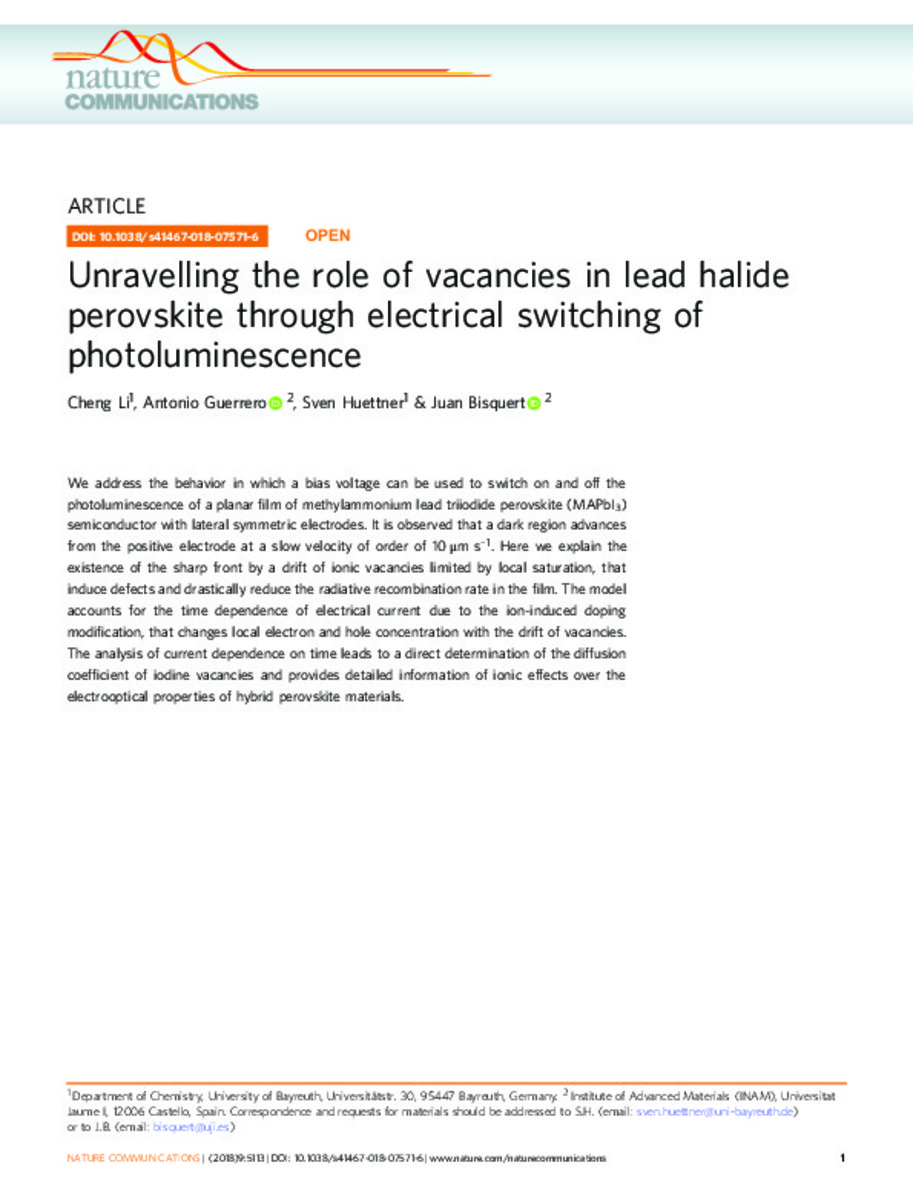Mostrar el registro sencillo del ítem
Unravelling the role of vacancies in lead halide perovskite through electrical switching of photoluminescence
| dc.contributor.author | Li, Cheng | |
| dc.contributor.author | Guerrero, Antonio | |
| dc.contributor.author | Huettner, Sven | |
| dc.contributor.author | Bisquert, Juan | |
| dc.date.accessioned | 2019-02-28T11:57:58Z | |
| dc.date.available | 2019-02-28T11:57:58Z | |
| dc.date.issued | 2018 | |
| dc.identifier.citation | LI, Cheng, et al. Unravelling the role of vacancies in lead halide perovskite through electrical switching of photoluminescence. Nature communications, 2018, vol. 9, no 1, p. 5113. | ca_CA |
| dc.identifier.issn | 2041-1723 | |
| dc.identifier.uri | http://hdl.handle.net/10234/181603 | |
| dc.description.abstract | We address the behavior in which a bias voltage can be used to switch on and off the photoluminescence of a planar film of methylammonium lead triiodide perovskite (MAPbI3) semiconductor with lateral symmetric electrodes. It is observed that a dark region advances from the positive electrode at a slow velocity of order of 10 μm s–1 . Here we explain the existence of the sharp front by a drift of ionic vacancies limited by local saturation, that induce defects and drastically reduce the radiative recombination rate in the film. The model accounts for the time dependence of electrical current due to the ion-induced doping modification, that changes local electron and hole concentration with the drift of vacancies. The analysis of current dependence on time leads to a direct determination of the diffusion coefficient of iodine vacancies and provides detailed information of ionic effects over the electrooptical properties of hybrid perovskite materials. | ca_CA |
| dc.format.extent | 8 p. | ca_CA |
| dc.format.mimetype | application/pdf | ca_CA |
| dc.language.iso | eng | ca_CA |
| dc.publisher | Nature Research | ca_CA |
| dc.relation.isPartOf | Nature Communicationsvolume 9 (2018) | ca_CA |
| dc.rights | © The Author(s) 2018. Open Access This article is licensed under a Creative Commons Attribution 4.0 International License, which permits use, sharing, adaptation, distribution and reproduction in any medium or format, as long as you give appropriate credit to the original author(s) and the source, provide a link to the Creative Commons license, and indicate if changes were made. The images or other third party material in this article are included in the article’s Creative Commons license, unless indicated otherwise in a credit line to the material. If material is not included in the article’s Creative Commons license and your intended use is not permitted by statutory regulation or exceeds the permitted use, you will need to obtain permission directly from the copyright holder. To view a copy of this license, visit http://creativecommons.org/ licenses/by/4.0/. | ca_CA |
| dc.rights | Atribución 4.0 Internacional | * |
| dc.rights.uri | http://creativecommons.org/licenses/by-sa/4.0/ | * |
| dc.title | Unravelling the role of vacancies in lead halide perovskite through electrical switching of photoluminescence | ca_CA |
| dc.type | info:eu-repo/semantics/article | ca_CA |
| dc.identifier.doi | https://doi.org/10.1038/s41467-018-07571-6 | |
| dc.relation.projectID | MAT2016-76892-C3-1-R ; RYC-2014-16809 | ca_CA |
| dc.rights.accessRights | info:eu-repo/semantics/openAccess | ca_CA |
| dc.relation.publisherVersion | https://www.nature.com/articles/s41467-018-07571-6 | ca_CA |
| dc.type.version | info:eu-repo/semantics/publishedVersion | ca_CA |
Ficheros en el ítem
Este ítem aparece en la(s) siguiente(s) colección(ones)
-
FCA_Articles [510]
Articles de publicacions periódiques -
INAM_Articles [517]
Excepto si se señala otra cosa, la licencia del ítem se describe como: © The Author(s) 2018. Open Access This article is licensed under a Creative Commons
Attribution 4.0 International License, which permits use, sharing,
adaptation, distribution and reproduction in any medium or format, as long as you give
appropriate credit to the original author(s) and the source, provide a link to the Creative
Commons license, and indicate if changes were made. The images or other third party
material in this article are included in the article’s Creative Commons license, unless
indicated otherwise in a credit line to the material. If material is not included in the
article’s Creative Commons license and your intended use is not permitted by statutory
regulation or exceeds the permitted use, you will need to obtain permission directly from
the copyright holder. To view a copy of this license, visit http://creativecommons.org/
licenses/by/4.0/.








